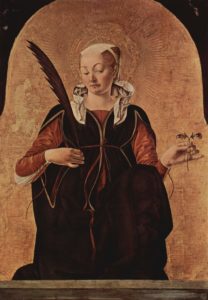Story by Guest Author: Diana Forest
Month 6, Rhythmic Moon of Equality
Organize * Balance * Equality
December 13, 2017 to January 9, 2018
December 13, 2017, Malkut Sepheroth, Planetary East
Wednesday, Yellow Solar Seed, Kin 204, Crown Chakra
December 13th, 2017
Today I learned about Saint Lucy or Saint Lucia of the Light. She was named that because she wore a crown of sorts on her head with candles mounted on the crown, so that she could see as she went through the darkness to share food and other needs with the Christians hiding in the Catacombs.
So the recent story is: I was at a celebration for St. Lucia, with a few ladies and one of them told us that she was at the hospital for an appointment and a lady, a stranger, came running in all excited and said look what I just photographed in the sky! Well! My friend, Annie, had been working towards planning this St. Lucia celebration and this was the day and, oh my! The photo looked like St.Lucia was in the clouds above the hospital! The lady who took the picture said she did not know what it meant. Annie told her all about St. Lucia, whose day it was today.
 Here is the picture. We never got the name of the lady that took the picture to give her credit – but when/if we do, she will be listed here! We give thanks!
Here is the picture. We never got the name of the lady that took the picture to give her credit – but when/if we do, she will be listed here! We give thanks!
This brought forward the interest to explore St. Lucia’s life and it is so profound I wanted to share it with Miriam’s readers. December 13th is Saint Lucia Day in some countries and religious cultures.
Quote from The Story of Saint Lucia by Sara Eilse: “The Holy Saint Lucia is the patron saint of Syracuse in Italy whose saint’s day falls on the 13th of December. Lucia is thought to have lived during the rule of Diocletian, and it was at the hands of his officials that she faced a martyr’s death.”
“But how did a Catholic saint’s day come to be celebrated in the Lutheran Scandinavia? According to the Julian calendar, the 13th of December is the shortest day of the year. (According to the Gregorian calendar which we now use, it is the 21st of December that has that particular honor.)”
“The Swedish have celebrated the Lucia-night (Lusse-nat), from the 16th century onwards, especially in the Western part of the country. In the morning hours of the 13th all the young girls in the household rise early to wake up the rest of the household with coffee and saffron-buns in the pitch-black of the Scandinavian winter mornings. It developed to become a countrywide tradition and to this day every Swedish city elects a Lucia-bride who goes on to the capital, Stockholm, to perhaps become the country’s Lucia-bride. Amongst her prizes is a trip to Syracuse.”
From The Wikipedia on St Lucia:
St. Lucia of Syracuse was honored in the Middle Ages and remained a well-known saint in early modern England.
“Lucia of Syracuse (283–304), also known as Saint Lucy or Saint Lucia (Latin: Sancta Lucia), was a young Christian martyr. “A number of traditions incorporate symbolic meaning of St. Lucy as the bearer of light in the darkness of winter, her feast day being December 13.”
At one point in Saint Lucia’s story, while having been converted and a devout Christian, she was inspired to give away her dowry because she had given her life to Christ, (she came from a wealthy family).
Her mother challenged her “… but Lucy countered, “…whatever you give away at death for the Lord’s sake you give because you cannot take it with you. Give now to the true Savior, while you are healthy, whatever you intended to give away at your death.”
The Story continues to say that when the soldiers came to take her away to punish her for being a Christian she could not be budged from her doorway even when they brought a team of Oxen to try to pull her out of her house. Then ” Bundles of wood were then heaped about her and set on fire, but would not burn. Finally, she met her death by the sword.”
From the Wikipedia link: “Lucy’s Latin name Lucia shares a root (luc-) with the Latin word for light, lux. A number of traditions incorporate symbolic meaning of St. Lucy as the bearer of light in the darkness of winter.”
(According to the Julian Calendar the longest night, which according to our Gregorian Calendar is Dec. 21st)
Gratitude to the resources quoted from, for the quotes of the story written here. Thank you!








